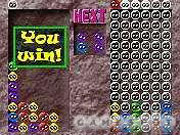Handheld game platforms and the puzzle genre go together like peanut butter and jelly. When combined, the handheld puzzle game makes the perfect time killer, doing its part to make bus rides, long flights, and other periods of waiting seem much shorter. While Nintendo launched its Game Boy Advance without a pure, Tetris-like puzzle game in its library, Nokia's new N-Gage hasn't forgotten about the format's roots, which date back to Tetris on the original Game Boy. Sega supplies the puzzle action here, with a version of its long-running Puyo Puyo series called Puyo Pop. While the game provides a competent take on Tetris-like gameplay, the presentation and no-frills approach to the game leave a lot to be desired.

Puyo Pop takes place in a Tetris-like well where two colored and connected blobs, called puyos, drop from the top of the well. It's up to you to rotate that two-blob piece and place it into the well. The object is to connect puyos of the same color together, and when you connect four or more puyos of one color, they pop and disappear. The idea behind the game is that you can make a series of puyos pop, then when the well rearranges itself by dropping all the puyos down to fill the new hole, more puyos link up and pop, and so on. Creating a chain reaction like that is the pathway to high scoring, and it's also the most effective way to defeat an opponent. Puyo Pop's main mode is a face-off against an AI opponent, and creating combos will cause clear puyos to fall into your opponent's playfield. Clear puyos only disappear when colored puyos pop directly next to them, making them a little cumbersome to deal with. When one player's well fills up to capacity, that player loses, and the game ends.
Aside from facing off against the AI in a very loose story mode, you can also play in practice mode, which is an endless game that lets you play on your own instead of trying to defeat an opponent as quickly as possible. The game also has support for two players using the N-Gage's built-in Bluetooth support and a puzzle mode that challenges you to accomplish different tasks, such as removing all red puyos from the pit, creating a three-pop chain, and so on.

While the gameplay is mostly intact from other installments in the series, the movement feels a little sluggish, like you can't move your pieces around quite as quickly as you should be able to. Some graphical effects from other installments are also missing here, such as the way like-colored puyos cling together when linked up. Beyond that, though, the game looks OK. The game's sound varies, and at times the music is very stuttery. The little fanfare that plays when you complete a stage in puzzle mode is the easiest place to find this stutter, but it happens rather often and really makes the game feel sloppy.
If you're an N-Gage owner in need of some portable puzzle action, Puyo Pop is your best bet, but the N-Gage's approach to this long-running, well-developed series just feels half-finished.